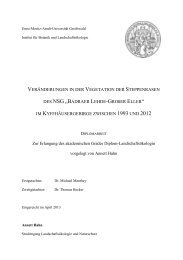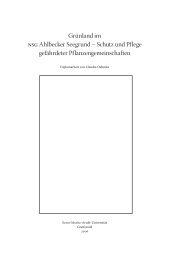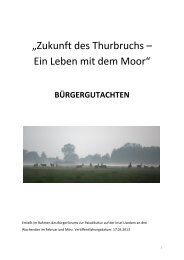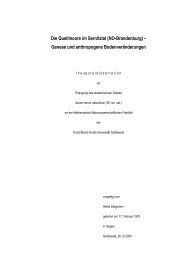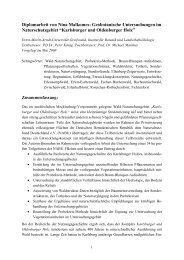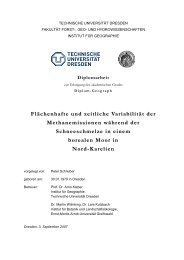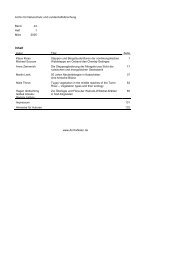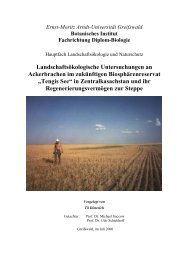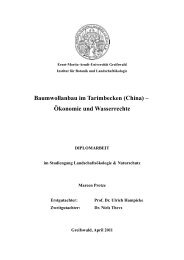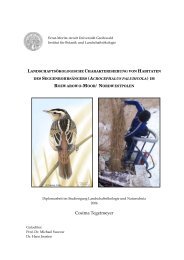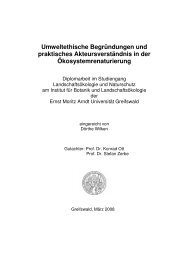und Standortentwicklung des wiedervernässten Grünlandes im ...
und Standortentwicklung des wiedervernässten Grünlandes im ...
und Standortentwicklung des wiedervernässten Grünlandes im ...
Erfolgreiche ePaper selbst erstellen
Machen Sie aus Ihren PDF Publikationen ein blätterbares Flipbook mit unserer einzigartigen Google optimierten e-Paper Software.
48 4. Untersuchungsergebnisse<br />
Typha latifolia lag dagegen mit durchschnittlichen Werten zwischen 13,72 g N/kg TS <strong>und</strong><br />
15,39 g N/kg TS <strong>im</strong> mittleren Bereich. Tabelle 15 zeigt die Ausbildung signifikanter<br />
Unterschiede der N-Gehalte von Carex riparia, Glyceria max<strong>im</strong>a <strong>und</strong> Typha latifolia zwischen<br />
den jeweiligen Beprobungsstandorten.<br />
Stickstoff [g/kg]<br />
22<br />
20<br />
18<br />
16<br />
14<br />
12<br />
10<br />
N =<br />
8<br />
CBa (5+/4)<br />
8<br />
CBb (6+/5)<br />
8<br />
CZc (5+/4)<br />
8<br />
CZd (5+/+)<br />
8<br />
GBa (5+/+)<br />
8<br />
GBb (6+/5)<br />
Probeentnahmestelle<br />
Abbildung 28: Stickstoffgehalt von Carex riparia, Glyceria max<strong>im</strong>a <strong>und</strong> Typha latifolia an<br />
ausgewählten Standorten<br />
(CBa = Carex riparia-Probefläche Bugewitz a, CBb = Carex riparia-Probefläche Bugewitz b, CZc = Carex riparia-Probefläche<br />
Zartenstrom c, CZd = Carex riparia-Probefläche Zartenstrom d, GBa = Glyceria max<strong>im</strong>a-Probefläche Bugewitz a, GBb =<br />
Glyceria max<strong>im</strong>a-Probefläche Bugewitz b, GZc = Glyceria max<strong>im</strong>a-Probefläche Zartenstrom c, GZd = Glyceria max<strong>im</strong>a-<br />
Probefläche Zartenstrom d, TBa = Typha latifolia-Probefläche Bugewitz a, TBb = Typha latifolia-Probefläche Bugewitz b, TZc =<br />
Typha latifolia-Probefläche Zartenstrom c, TZd = Typha latifolia-Probefläche Zartenstrom d)<br />
Tabelle 15: Signifikanztest der Stickstoffgehalte der oberirdischen Biomasse an den<br />
verschiedenen Standorten<br />
Carex riparia Glyceria max<strong>im</strong>a Typha latifolia<br />
CBa CBb CZc CZd GBa GBb GZc GZd TBa TBb TZc TZd<br />
- n n s CBa - s n n GBa - n n s TBa<br />
n - n n CBb s - s s GBb n - n s TBb<br />
n n - n CZc n s - n GZc n n - s TZc<br />
n n n - CZd n s n - GZd s s s - TZd<br />
(CBa = Carex riparia-Probefläche Bugewitz a, CBb = Carex riparia-Probefläche Bugewitz b, CZc = Carex riparia-Probefläche<br />
Zartenstrom c, CZd = Carex riparia-Probefläche Zartenstrom d, GBa = Glyceria max<strong>im</strong>a-Probefläche Bugewitz a, GBb =<br />
Glyceria max<strong>im</strong>a-Probefläche Bugewitz b, GZc = Glyceria max<strong>im</strong>a-Probefläche Zartenstrom c, GZd = Glyceria max<strong>im</strong>a-<br />
Probefläche Zartenstrom d, TBa = Typha latifolia-Probefläche Bugewitz a, TBb = Typha latifolia-Probefläche Bugewitz b, TZc =<br />
Typha latifolia-Probefläche Zartenstrom c, TZd = Typha latifolia-Probefläche Zartenstrom d, n = Unterschied ist nicht signifikant,<br />
s = Unterschied ist signifikant, á = 0,5, t = 2,31)<br />
Zwischen der N-Konzentration <strong>und</strong> der Höhe <strong>des</strong> C/N-Verhältnisses bestand eine enge<br />
Beziehung. Proben mit sehr niedrigen N-Gehalten besaßen auch <strong>im</strong>mer ein sehr hohes C/N-<br />
Verhältnis. Die C/N-Verhältnisse zwischen Carex riparia <strong>und</strong> Typha latifolia zeigten keinen<br />
8<br />
GZc (5+/+)<br />
8<br />
GZd (6+/5)<br />
8<br />
TBa (5+/+)<br />
8<br />
TBb (6+/5)<br />
8<br />
TZc (5+/+)<br />
8<br />
TZd (6+/+)



